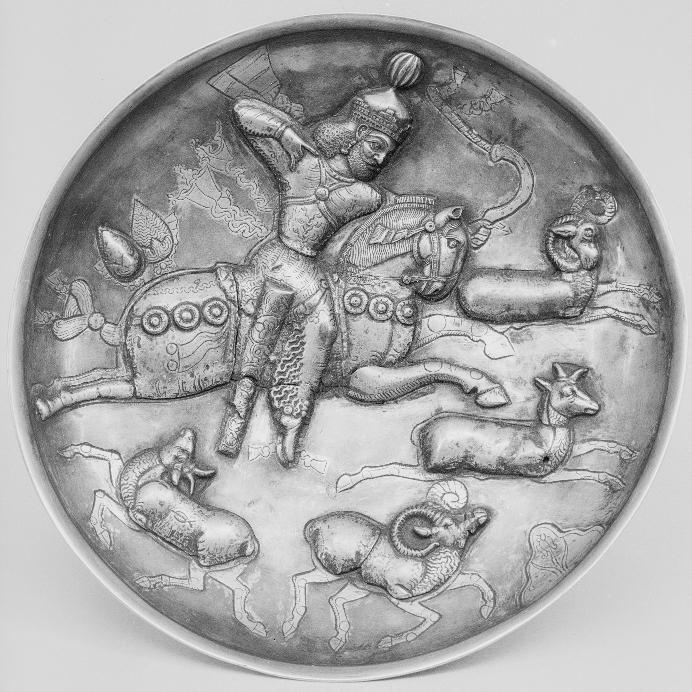|
|
The "Burnett Plate"
A Sasanian King Hunting Mountain Sheep

A larger image of the "Burnett Plate", A Sasanian King Hunting Mountain Sheep
Period: Sasanian
Date: ca. A.D. 310–79
Geography: Iran
Culture: Sasanian
Medium: Silver, partly gilt
Dimensions: Height: 1.9 inches (4.8 cm) Diameter: 9.13 inches (23.2 cm)
Credit Line: Cora Timken Burnett Collection of Persian Miniatures and Other Persian Art Objects, Bequest of Cora Timken Burnett, 1956
The Metropolitan Museum of Art, New York. Accession Number: 57.51.19
The well-known unique Sasanian silver plate of Yazdigird II (438-57) or Valāsh (484-88) and his queen from the Walters Art Gallery20 (gallery XI, case 39E)
and another newly discovered silver plate of the same period belonging to Mrs. Cora Timken Burnett were two of the main points of interest in gallery XI,
which showed many extraordinary pieces from the Achaemenid until the early Islamic period.
The Burnett plate (case 40) is decorated with a king on horseback hunting ibex (Fig. 12);
a buck and a doe are seen running toward the right and, again, in characteristic Sasanian fashion, dead at the bottom, marked by a hill symbol.
On the reverse an inscription has been engraved, which has not yet been read.
By its peculiar technique of applied repoussée, forming a high relief enhanced by engraving and gilding,
this piece falls easily within a well-known group which comprises a plate with a boar-hunting ruler in the Freer Gallery21
and two other plates with antelope-hunting kings in the Hermitage22 and the Metropolitan Museums.23
Until recently the Freer and the Hermitage pieces have been thought to represent Shāpūr II ( 310-79 A.D.),
to whom the catalogue also attributes the Burnett plate and the Metropolitan Museum piece Khusraw I (531-79 A.D.).
New investigations by Herzfeld have shown that the Metropolitan Museum piece has to be attributed to Pērōz I (457-85 A.D.),24
whereas the crown of the ruler on the Freer plate, on account of the fluted ball placed over the mural crown, cannot represent an official royal crown of a Sasanian king.
It is impossible, therefore, to attribute it definitely to one particular Sasanian ruler, though stylistically it may very well be from the end of Shāpūr’s reign.
As Herzfeld has demonstrated,25 the fluted ball, which is also the distinguishing feature of the Mrs. Burnett’s plate, occurs first on Eastern coins of the third century;
in Persia proper it is of symbolic value as parts of standards and becomes also a characteristic feature on as yet unidentifiable helmets of the Persian kings.
The crowns on the Freer and Burnett plates are hybrid combinations of helmet and crown emblems.
Such agglomerations would be out of place on the official coinage, but can be very well explained on non-documentary objects like silver plates.
20 E. Herzfeld, “Khusraw Parwēz und der Tāq i Vastān,” Archaeologische Mitteil. aus Iran, IX (1938), 119-21, 126, No. 12.
21 J. Orbeli, “Sāsānian and Early Islamic Metalwork.” A Survey of Persian Art (London and New York, 1938), IV, Pl. 211.
22 Ibid., Pl. 209.
23 Ibid., Pl. 213; this plate is fragmentary
24 Herzfeld, op. cit., p. 119, Pl. VIII.
25 Ibid., pp. 129-40.
Source: pp. 113-114, Richard Ettinghausen, “Six Thousand Years of Persian Art,” The Exhibition of Iranian Art, New York, 1940 in Ars islamica v.7
|
|